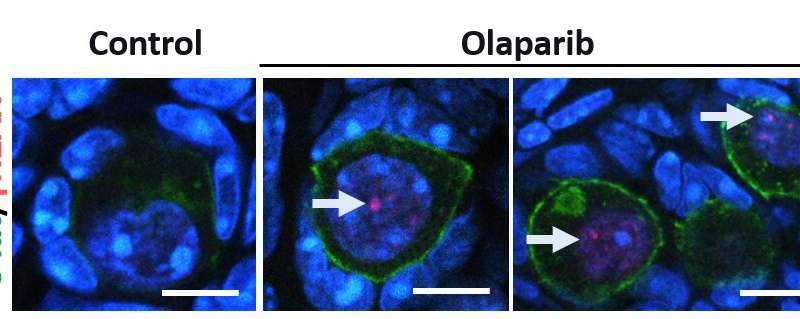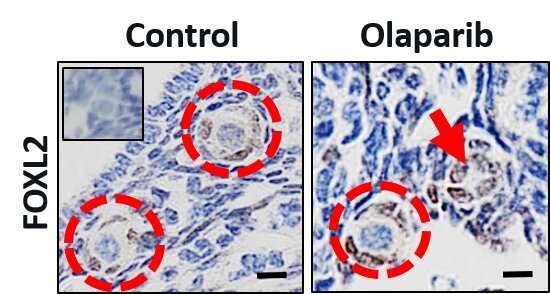
Australian researchers have shown for the first time that a new drug used to treat breast cancer patients damages the store of immature eggs in the ovaries of mice.
The authors of the study, which is published today in Human Reproduction, one of the world’s leading reproductive medicine journals, say the drug olaparib is being used to treat young as well as older women with breast cancer that is driven by mutations in the BRCA1/2 genes, but without knowing its effect on fertility.
Their research shows that olaparib destroys a significant proportion (36%) of the immature eggs that are contained in structures called primordial follicles. Women are born with a finite number of follicles in their ovaries and during their reproductive lifespan some of the eggs (or oocytes) will start to grow to the stage at which they are released from the ovaries and can be fertilised by sperm. Therefore, a reduction in the store of follicles through damage from cancer treatment has the potential to affect a woman’s fertility.
Olaparib has not been used on young women long enough to see how it affects their fertility, so this study in mice is an important indication of its effects.
First author of the study, Dr. Amy Winship, a research fellow at Monash University’s Biomedicine Discovery Institute (Melbourne, Australia), said: “Although there are differences between species, such as the number of eggs ovulated in a menstrual cycle, there are many important similarities that make the mouse an excellent model for studying the human ovary. The storage of primordial follicles, and the processes of activation, growth and ovulation are all the same.
“Fertility is very commonly overlooked in many safety tests in pre-clinical studies in animal models and also in human clinical trials for new cancer drugs. But we know this is an important and valid concern of young cancer patients and survivors, particularly as survival rates for many cancers are improving. We show for the first time that olaparib is harmful to the immature eggs stored in the ovaries that will give rise to the mature eggs required to sustain fertility and normal hormone levels.”
Olaparib inhibits DNA repair by blocking the action of a family of enzymes called poly(ADP-ribose) polymerase or PARP, and so the drug is used to prevent cancer cells repairing themselves and continuing to replicate and grow. In 2018, olaparib was approved for use in women with BRCA1/2 breast cancer that had spread (metastasised) to other parts of the body. A randomised controlled trial, OlympiA, is currently investigating its use in women with early, potentially curable BRCA1/2 breast cancer that has not yet metastasised. Many of these will be young women who have yet to start or complete a family.

The researchers gave mice a single dose of chemotherapy (cyclophosphamide, doxorubicin, carboplatin or paclitaxel) or a placebo, followed by a daily dose of olaparib or a placebo for the next 28 days. Then the mice were killed humanely and the researchers counted the number of primordial follicles and growing follicles in the ovaries. They also counted the number of follicle remnants, in which the eggs had been destroyed.
“We found that olaparib significantly depleted primordial follicles by 36% compared to ovaries of mice who had not received the drug,” said Dr. Winship. “We detected a significant accumulation of primordial follicle remnants in mice given olaparib, while these were rarely detected in the ovaries of the untreated mice, indicating that olaparib is likely to destroy immature eggs. Olaparib did not affect growing eggs and follicles or hormone levels.
“If a drug kills growing eggs, ovulation and fertility might be temporarily impacted, but more eggs can be activated from the immature primordial stockpile and ovulation will resume as normal. In contrast, if the primordial eggs are killed, this is more serious. This can ultimately lead to complete infertility and early menopause once the stockpile is gone. We have shown for the first time, olaparib kills primordial, but not growing eggs and follicles.”
Although mice treated with chemotherapy had reduced numbers of primordial follicles in their ovaries, the researchers found that olaparib did not exacerbate this loss when compared with mice that received chemotherapy but not olaparib.
In their paper, the researchers conclude: “Since direct measures of primordial follicle number are not possible in women, our data presented here have important clinical implications. Female cancer patients may present clinically with regular menstrual cycles and serum AMH concentrations within the normal range after olaparib treatment, but, unknowingly have a significantly depleted ovarian reserve of primordial follicles. Diminished ovarian reserve leads to infertility and premature menopause. Therefore, fertility preservation counselling should be considered for young female patients prior to olaparib treatment.”
Anti-Mullerian Hormone (AMH) is often used to assess the reserve of follicles in a woman’s ovary, but AMH levels were unaffected by olaparib, which could lead to a false sense of reassurance among women and their fertility doctors.
Professor Kelly-Anne Phillips is a medical oncologist at the Peter MacCallum Cancer Centre, Melbourne, Australia, and an author of the paper. She said: “Although the OlympiA trial of olaparib includes younger women with early breast cancer, at present the drug is approved only for use in women with metastatic breast cancer for whom fertility preservation is not appropriate. However, in future olaparib and similar drugs may be approved for use in young women, with the intention of curing them of the disease, and for these women fertility preservation is an important consideration. Therefore, it is very important to understand its effects on ovarian function and we encourage researchers to consider measuring ovarian function and fertility in future clinical trials so that we have data from humans to support or refute the findings of our study in mice.”
Source: Read Full Article